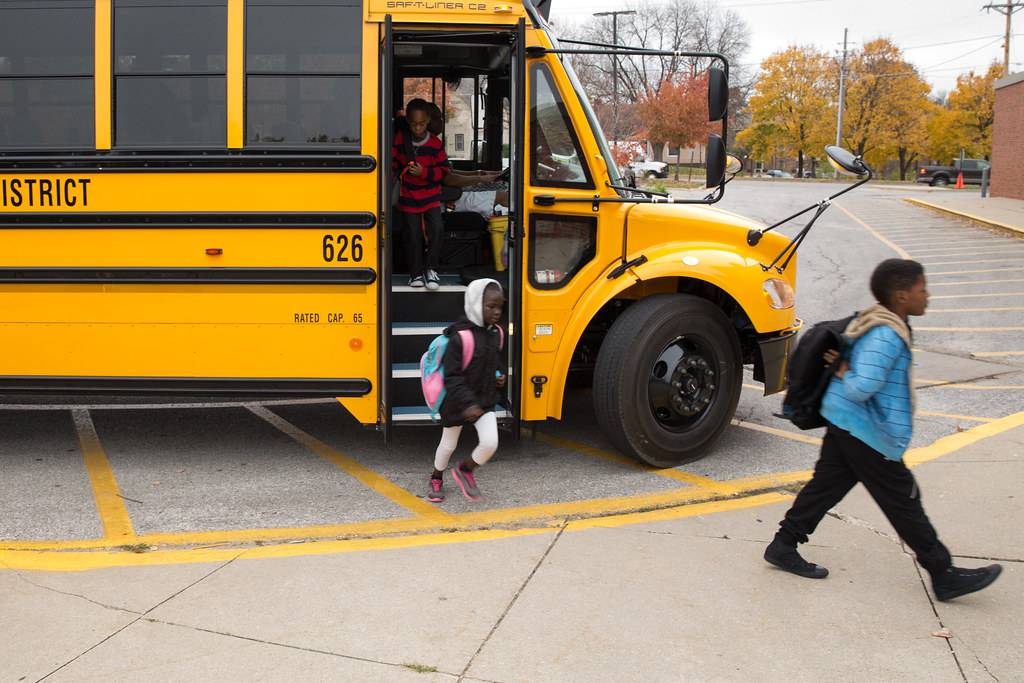Are you ready for your child’s first school bus ride? It’s an exciting adventure that opens doors to new opportunities, friendships, and unforgettable experiences!
But you might be wondering how to best prepare your child for school bus rides. Luckily, at Omega Pediatrics, we’ve got your back! Our guide is packed with valuable insights and practical tips to ensure your child has safe, enjoyable, and amazing school bus rides!

What to Expect on Your Child’s First School Bus Ride
Embarking on your child’s first school bus ride can be an exciting milestone, but it’s natural to have questions and concerns. Understand what to expect. So, both you and your child can feel more confident and prepared for this new experience.
1. There’s a bus schedule.
Arrive at the bus stop a few minutes early. That’s because the school bus may be following a strict schedule. This allows your child to get settled and ensures that the bus arrives without any rush or stress. Being punctual sets a positive tone for the day and reduces anxiety.
2. There are bus rules to follow.
Every school bus has its own rules. These are mostly bus safety rules that your child should follow. Review these rules beforehand and explain them to your child.
Reinforce to your kids that following them ensures their safety and the safety of their peers. Consider practicing bus safety at home, role-playing different scenarios, and discussing what to do in case of an emergency.
3. Expect a bus monitor or chaperone.
On many school buses, there may be a bus monitor or chaperone responsible for supervising the children during the ride. This person plays a vital role in maintaining order and safety, making sure everyone follows the bus rules. They also assist with boarding and disembarking.
Let your child know that the bus monitor is there to help. Knowing there’s an additional adult on the bus who is looking out for their well-being can provide reassurance for your child.
4. There might be potential traffic delays.
Traffic delays are common, especially during peak hours. Prepare your child for the possibility of delays, and teach them to be patient and calm while waiting. Explain that traffic is beyond anyone’s control and that occasional delays are normal.
Encourage your child to bring a book, puzzle, or favorite toy to keep them occupied. Remind them that the bus will arrive eventually, and they will safely reach their destination.
By setting realistic expectations and equipping your child with coping strategies, you can help them navigate potential traffic delays with ease.
5. The ride may be very noisy and have a lot of vibrations.
Buses can be noisy and may have sudden movements. Prepare your child for the noise and motion by reassuring them that it’s a normal part of the bus ride experience. Explain that the noise comes from the engine and general bus operations.
Reinforce that these movements are normal and that the bus driver is skilled in maneuvering the vehicle safely. By addressing these potential concerns upfront, you can alleviate any anxiety your child may have about the bus ride.
6. There will be other children.
Tell your child to be friendly and respectful toward other children. The school bus ride is an opportunity to make new friends and socialize. So, encourage simple acts of kindness, such as sharing a seat or engaging in polite conversation, to gain new friends.
Teach your kids basic social skills to help them initiate interactions and learn to accept others’ differences. Let your kid have a positive and friendly attitude. Your child can create a supportive and enjoyable bus ride environment for themselves and their peers.
School Bus Safety: What Your Child Should Know
1. Get to the bus stop early.
Arrive at the bus stop at least five minutes before the bus is scheduled to arrive. School buses strictly follow a schedule. Instill in your children the habit of being punctual to avoid undue stress and anxiety. Also, there’ll be no rush, setting a positive tone.
2. Stand back from the curb.
Stand at least three giant steps or six feet away from the curb while waiting for the bus. This is a safe distance for the child and the approaching bus. Explain to your children the importance of roadside safety.
3. Wait for the bus to come to a complete stop.
Wait for the bus to fully stop before approaching it. This allows the driver to open the doors and ensures that it is safe for your child to board. Remind them to be patient and not rush towards the bus.

4. Watch your step while entering or exiting the bus.
Remind your child to watch their step when entering or exiting the bus. Encourage them to pay attention to the ground and use the handrail provided. Explain that the bus steps may be steeper than what they are used to, and being cautious can prevent trips and falls.
Reinforce the importance of taking their time and not rushing when getting on or off the bus. By practicing careful stepping, your child reduces the risk of accidents and maintains their safety during transitions.
5. Keep the aisle clear of bags or other objects.
Instruct your child to keep the bus aisle clear of any bags or objects to maintain a safe passage for all passengers. Explain to them that objects in the aisle can cause tripping hazards and prevent easy movement inside the bus.
Encourage them to store their belongings either on their lap or under the seat. By keeping the aisle clear, they contribute to a safer environment for everyone on the bus.
6. Follow the bus driver’s instructions at all times.
Let your child listen to and follow the bus driver’s instructions without hesitation. The bus driver knows what’s best and is responsible for everyone’s safety. Explain that the bus driver has the authority to enforce rules and ensure that the school bus is safe to ride.
Encourage your child to show respect and cooperation by following directions promptly. By doing so, they contribute to a safe and organized bus environment for everyone.
7. Never put any body part out of the bus window.
Emphasize that it is never safe to extend any body part—head, arms, hands, or elbow—outside the bus window, no matter the circumstances. Explain the potential risks of serious injuries or accidents.
8. Don’t throw objects inside or outside the bus.
Throwing objects can cause harm to others or damage property. Tell your child to treat the bus and its surroundings with respect. Also, keep their belongings secure and avoid any behavior that may endanger themselves or others.
By promoting responsible behavior, you help create a safe and pleasant environment for everyone on the bus.
9. Wait for the bus to fully stop before standing up from your seat.
Tell your child to wait for the bus to come to a complete stop before standing up from their seat to ensure safety from accidents or falls. Sudden stops or movements may occur during the bus ride; remain seated until the bus has fully stopped.
Reinforce the idea of being patient and waiting for the appropriate time to stand up and exit their seat. By following this rule, your child minimizes the risk of injuries

10. Never walk behind the bus.
Let your child understand the danger of walking behind the bus. Never attempt to walk behind the bus after going down, especially when it’s backing up or preparing to depart. The bus driver may not be able to see them, and accidents may occur.
Let them maintain a safe distance from the bus at all times and use designated areas for crossing the street. By avoiding walking behind the bus, your child reduces the risk of being involved in a dangerous situation.
11. Be aware of the emergency exits and evacuation procedures.
Familiarize your child with the location of emergency exits on the bus and the evacuation procedures. In case of an emergency, your child needs to be prepared to exit the bus quickly and safely.
Also, discuss the importance of staying calm and following the instructions of the bus driver or other authority figure during an evacuation. Your child can respond appropriately in unexpected situations if he’s calm.
12. Report any damage or issues to the bus driver or school authorities
It’s important to notify the appropriate individuals if your child notices anything that may compromise the safety of the bus or its passengers. By taking an active role in reporting concerns, your child contributes to maintaining a safe and well-maintained bus environment.
Overall, children should expect a safe and orderly ride while on the school bus, and they should follow the rules to ensure their safety and others, too. Parents and guardians should take time to discuss the importance of safety information with their children.
Turn Boring School Bus Rides into Fun Ones
Preparing your child for school bus rides is essential for ensuring their safety, comfort, and enjoyment. With these insights and tips, you can turn what might have been perceived as boring school bus rides into fun and enjoyable experiences for your child.
By being prepared and proactive, you can help your child embrace the school bus as a gateway to new adventures, friendships, and learning opportunities!
Omega Pediatrics wants to make sure that your children have a safe back-to-school experience. We provide many articles related to helping your child prepare for the school season to guide you.


